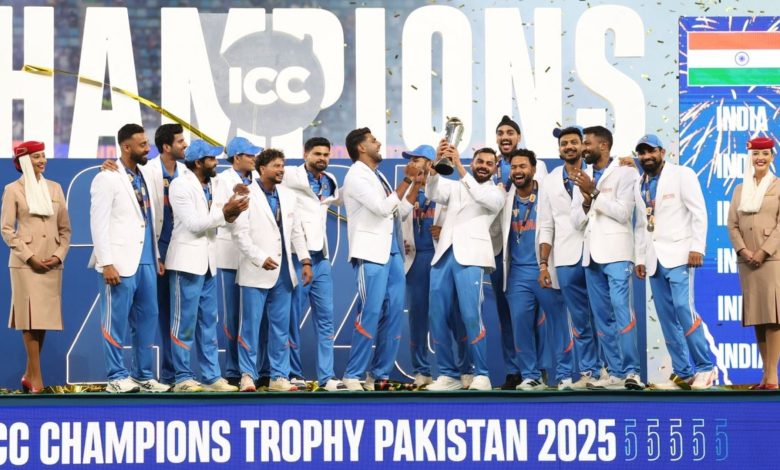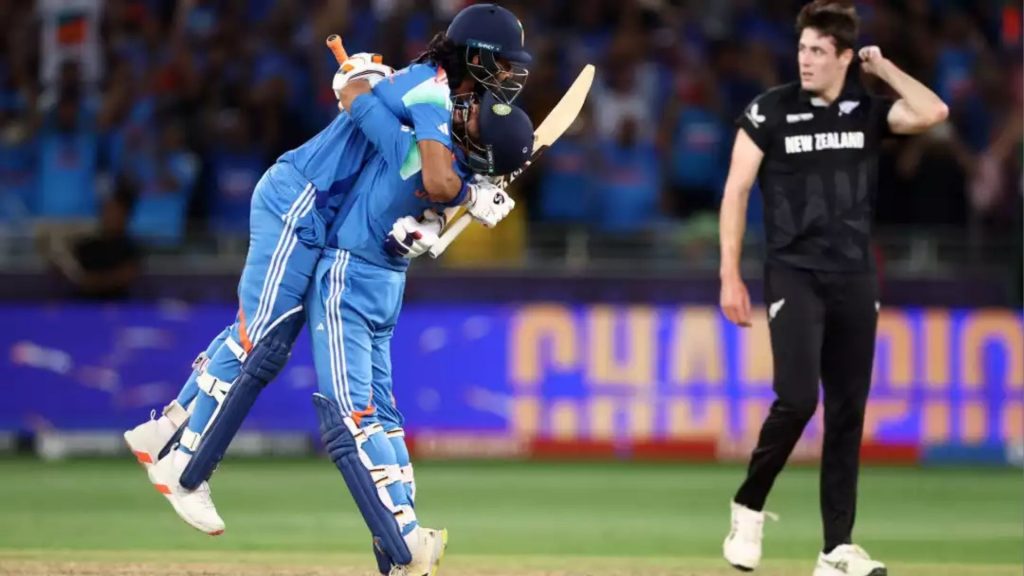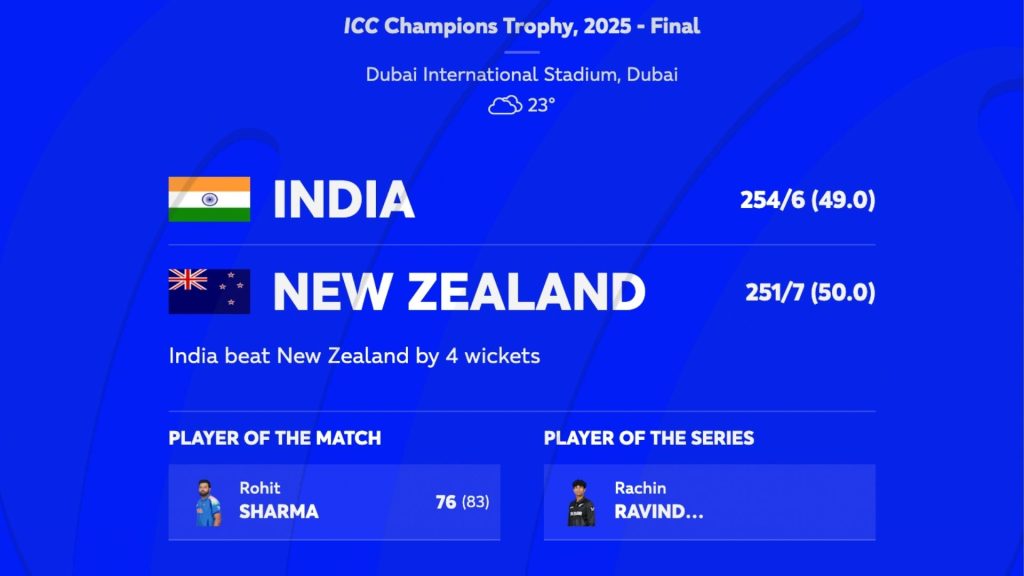
The excitement was palpable at the Champions Trophy 2025, and cricket fans witnessed a dramatic showdown when India edged New Zealand by four wickets in a nail-biting final in Dubai. In this post, we delve into the match details, key turning points, and standout performances that made the victory a historic moment for Indian cricket. Alongside detailed commentary, we provide SEO-optimized content that ensures you have all the insights you need to understand how India emerged as champions.
Suggested image placement:
Place a high-resolution hero image of the match or stadium at the top of the article with the alt text “Champions Trophy 2025 Final in Dubai – India vs New Zealand.”
Match Overview
India and New Zealand had already clashed earlier in the tournament during the group stage in Dubai. However, the final proved to be a different beast. India’s journey through the tournament had been nothing short of spectacular—unbeaten and determined after their semi-final win against Australia. Despite New Zealand’s consistent performances, especially highlighted by their comprehensive win over South Africa in the final four, the final day saw India harness their momentum and tactical discipline to clinch the trophy.
The match witnessed India posting a competitive total of 254/6. While the Black Caps had momentarily shown resistance by scoring 251/7, the duo of KL Rahul and Ravindra Jadeja ensured that India completed the chase with just one over to spare.

Key Moments and Tactical Analysis
A Strong Start by the Openers
Rohit Sharma and Shubman Gill were instrumental in setting the tone for India’s innings. Their partnership of 105 runs for the first wicket gave India the confidence needed early on. Despite a scintillating catch by New Zealand’s Glenn Phillips that saw Gill dismissed for 31, the foundation laid by the openers remained vital.

Middle-Order Resilience
After the loss of early wickets, India’s middle order came to the forefront. With New Zealand bowling a disciplined campaign, the spinners Varun Chakaravarthy and Kuldeep Yadav played a crucial role by taking early breakthroughs. Their control in the middle overs helped to slow down the scoring rate, ensuring that New Zealand never built too large a lead.
Captain Rohit Sharma’s innings was also notable—his dismissal, stumped by Tom Latham for 76, marked a turning point where the responsibility shifted to KL Rahul and Ravindra Jadeja. This partnership, marked by calm and calculated scoring, ultimately sealed the win.
New Zealand’s Fighting Spirit
Even though New Zealand lost the final, their performance throughout the match was commendable. Opening batsmen Will Young and Rachin Ravindra had started with a promising partnership, but as the Indian bowlers began to find their rhythm, wickets fell at crucial junctures. Michael Bracewell’s half-century, reached with just one ball remaining, was a testament to the resilience and fighting spirit of the Black Caps.
New Zealand’s fielding, despite missing key players like Kane Williamson—who was sidelined due to a quad injury—was aggressive and committed. Glenn Phillips’ athleticism was on full display with his exceptional catch that not only dismissed Shubman Gill but also shifted the momentum.

The Role of Spin and Pressure
The middle overs were dominated by India’s spinners, whose precision and strategic use of flight and turn brought New Zealand’s batsmen under pressure. Varun Chakaravarthy’s breakthrough, dismissing Will Young lbw, was a key moment that dampened New Zealand’s momentum. Similarly, Kuldeep Yadav’s quick-fire overs not only restricted the run flow but also took advantage of any lapse in the New Zealand batting lineup.
The spinners’ ability to maintain a low run-rate—restricted to 3.30 runs per over in a crucial phase—demonstrated India’s tactical depth. This control proved critical as it left the opposition with minimal opportunities to score freely during the middle overs.
Finishing the Game
As the match entered its final stage, the pressure mounted on both sides. With New Zealand managing a late surge by scoring an additional 50 runs in the final five overs, it was clear that the game would be decided in the death overs. India’s response came in the form of a composed partnership between KL Rahul and Ravindra Jadeja. Their calculated aggression ensured that India crossed the finish line, ultimately finishing on 254/6.

Standout Performances
Rohit Sharma and the Opening Partnership
Rohit Sharma’s leadership and batting technique were exemplary throughout the tournament. His early partnership with Shubman Gill set the stage for a match-defining performance. Sharma’s ability to build a solid foundation and guide his team through high-pressure situations has been a recurring theme in India’s recent successes.
KL Rahul and Ravindra Jadeja’s Finishing Touch
In high-pressure matches, the ability to remain composed is essential. KL Rahul’s experience and Ravindra Jadeja’s all-round prowess were pivotal in the final moments of the match. Their partnership was not just about chasing down the target but also about managing the game’s pace and ensuring that every ball counted. Jadeja’s calm under pressure and precise field placements highlighted his role as a match-winner.
The Unsung Heroes: Spinners Varun and Kuldeep
While the batsmen received most of the attention, the spinners Varun Chakaravarthy and Kuldeep Yadav were equally important. Their performance in the middle overs—restraining the New Zealand batsmen and picking crucial wickets—provided India with the platform needed to build a winning total. Their disciplined bowling not only contained the opposition but also tilted the balance in India’s favor.
In-depth Tactical Insights
Batting Under Pressure
India’s batting strategy was a blend of aggression and smart pacing. Starting strong with a 105-run opening partnership, the team demonstrated a clear plan: build a solid foundation, maintain a steady run rate in the middle overs, and then accelerate as needed in the final overs. This approach allowed them to chase a target that was within reach despite the late surge from New Zealand.
Bowling and Fielding Strategies
The Indian bowling unit, particularly the spinners, executed a well-thought-out plan. By consistently targeting the New Zealand batsmen’s weaknesses, the bowlers created pressure that eventually led to crucial breakthroughs. The fielding, both in terms of energy and placement, was equally noteworthy. Key dismissals, such as the athletic catch by Glenn Phillips, while costly for New Zealand, also demonstrated the high stakes and intensity of the match.
Adapting to Conditions
Dubai’s conditions often play a significant role in shaping the game. The pitch, known for its balanced pace and turn, was exploited by both teams. However, India’s ability to adapt quickly—adjusting their batting strategy and effectively utilizing their spin options—was a decisive factor in their success.
Post-Match Reactions and Future Implications
Celebrations and Reflections
Following the final whistle, celebrations erupted as India lifted the Champions Trophy 2025. The victory has reignited discussions among fans and analysts about India’s long-term strategy and their potential in upcoming tournaments. Players and coaching staff have hailed the win as a testament to their hard work, determination, and tactical acumen.
What Lies Ahead?
While this victory is a significant milestone, it is only the beginning for the Indian cricket team. With major tournaments on the horizon, the lessons learned from the Champions Trophy final will undoubtedly influence future strategies. Cricket enthusiasts are already speculating on how India might evolve their game plan, especially in balancing pace with spin and enhancing fielding standards.
The Broader Impact on Cricket
The match also had wider implications for international cricket. It underscored the importance of adaptability, team spirit, and the relentless pursuit of excellence. For fans, it provided a masterclass in cricket strategy—a game where every run, wicket, and field placement plays a crucial role in determining the outcome.
The Champions Trophy 2025 final between India and New Zealand will be remembered as a classic example of resilience, strategy, and unyielding determination. From the early dominance of the openers to the nail-biting finish orchestrated by KL Rahul and Ravindra Jadeja, every moment of the match showcased the best of international cricket. India’s victory not only reflects their current form but also hints at a promising future where tactical brilliance meets raw talent on the world stage.
As we celebrate this remarkable achievement, it’s worth revisiting the key elements that made this win possible:
- A strong start by openers setting the tone for the match.
- Strategic spin bowling that kept New Zealand’s scoring in check.
- Calm and calculated finishing by the middle order in the final overs.
- An overarching team strategy that adapted perfectly to the challenging conditions in Dubai.
This victory is more than just a trophy—it is a symbol of India’s evolution in cricket, where every player contributes to a larger team effort. With lessons learned and momentum gained, the road ahead looks bright for Indian cricket.




